Wilhelm Dieterle (1893-1972) a.k.a. William Dieterle was a German actor and director who started out in Weimar cinema, before becoming a well-known Hollywood director.

German postcard by Verlag Hermann Leiser, no. 3075. Photo: Atelier Oertel, Berlin-Wilm.
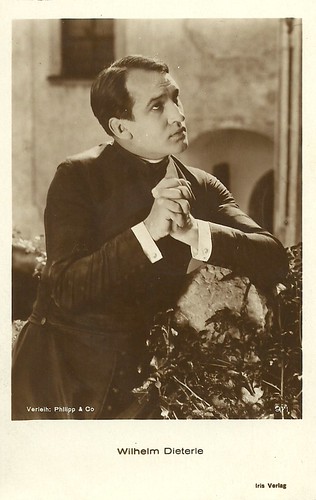
Austrian postcard by Iris Verlag, no. 971. Photo: Philipp & Co. Perhaps a card for the film Das Geheimnis des Abbe X (1927), directed by Dieterle himself, or for Der Pfarrer von Kirchfeld (1926), directed by Jakob and Luise Fleck.

German postcard by Ross Verlag, Berlin. Photo: Zelnik-Film. Wilhelm Dieterle in Die Weber/The Weavers (Friedrich Zelnik, 1927).
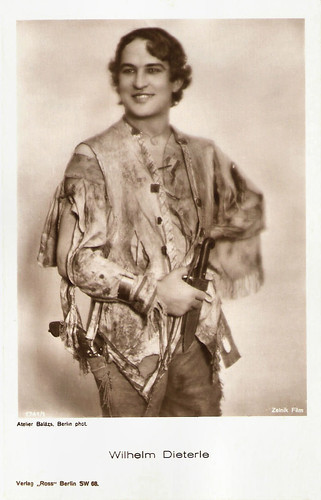
German postcard by Ross Verlag, no. 1741/1, 1927-1928. Photo: Atelier Balazs, Berlin / Zelnik Film.

German postcard by Verlag Hermann Leiser, Berlin-Wilm., no. 3926. Photo: Atelier Oertel, Berlin.
Wilhelm Dieterle was born in Ludwigshafen am Rhein in 1893. He was the youngest child of nine, to poor Jewish parents, Jacob and Berthe Dieterle. He took acting lessons at a young age and began his career as a stage actor in 1911 at the theatre in Arnsberg. This also included work as an extra, singer, dancer and stagehand; hence his white gloves, which he continued to wear in Hollywood.
His striking good looks and ambition soon paved the way as a leading romantic actor in theatre productions. In 1912-1914, he worked at theatres in Heilbronn, Plauen and Bad Dürkheim, and in 1914-1917 in Mainz under the direction of future film director Ludwig Berger. In 1917-1918 he played in Zürich, in 1918-1919 in Berlin and in 1919-1920 in Munich. He had his breakthrough in 1920-1923 with Max Reinhardt’s Deutschen Theater in Berlin. In this era, he mainly worked there, next to sidesteps with the companies of Leopold Jessner, Viktor Barnowsky and Karlheinz Martin. In 1924 Dieterle had his own theatre company, but it was short-lived.
His first film performance was in the Friedrich Schiller adaptation Fiesko (Carl Hoffmann, Phil Jutzi, 1913). He took up film acting from 1919 on in films like Die Vermummten/The Disguised Ones (Franz Seitz, 1920). All through the 1920s, he appeared in numerous films.
Dieterle appeared in major classics of the Weimar era. He was Henny Porten’s ill-fated fiancé and Fritz Kortner’s rival in love in the Kammerspiel Hintertreppe/Backstairs (Leopold Jessner, 1921). Actually, he was often paired with Porten, before Hintertreppe also in Die Geier-Wally/Wally of the Vultures Ewald André Dupont, 1921), and afterwards in Frauenopfer/Women's Sacrifice (Karl Grune, 1921).
Dieterle also was the poet, the Persian baker and the Russian prince in the Harun al Raschid and Iwan the Terrible sequences in Das Wachsfigurenkabinett/Waxworks (Paul Leni, 1923-1924). He played Henny Porten’s young husband in the internationally popular Mutter und Kind/Mother and Child (Carl Froehlich, 1924). He also played Gretchen’s brother Valentin in Friedrich Wilhelm Murnau’s Faust (1926), who was killed by Mephisto.

German postcard by Ross Verlag, no. 646/4. Photo: Henny Porten-Film. Henny Porten and Wilhelm Dieterle in Die Geierwally aka Die Geier-Wally (E.A. Dupont, 1921), based on the novel by Wilhelmine von Hillern. The sets were by Paul Leni.
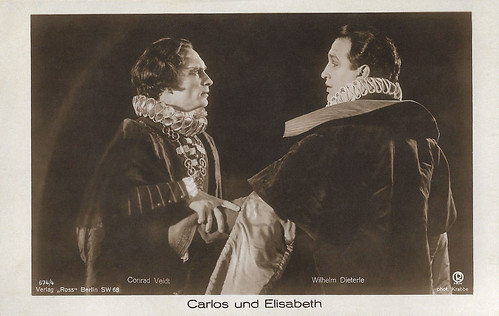
German postcard by Ross Verlag, Berlin, no. 674/4. Photo: Krabbe / RO-Film. Conrad Veidt as Don Carlos and Wilhelm Dieterle as Marquis Posa in Carlos und Elisabeth/Carlos and Elisabeth (Richard Oswald, 1924).
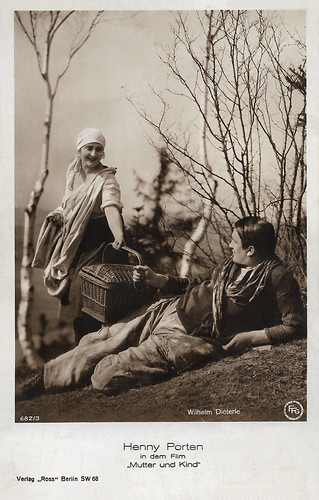
German postcard by Ross Verlag, no. 682/3. Photo: FFG (Froehlich-Flm GmbH). Henny Porten in Mutter und Kind/Mother and Child (Carl Froehlich, 1924), co-starring Wilhelm Dieterle.

German postcard by Ross Verlag, no. 1469/1, 1927-1928. Photo: Aafa Film. Wilhelm (William) Dieterle in Zopf und Schwert - Die tolle Prinzessin (Victor Janson, 1926).

German postcard by Ross Verlag, no. 66/4. Photo: Ufa. Publicity still for Faust (1926) with Camilla Horn.
From 1923 on, Wilhelm Dieterle directed his first films, in which he always played the lead. He started with the Heimat film Der Mensch am Wege/Man by the Roadside (1923), in which Marlene Dietrich played one of her first roles. The major example of his own output was Geschlecht in Fesseln/Sex in Chains (1928), one of the films produced by his own company Charha (1927), which he ran with his wife, scriptwriter and actress Charlotte Hagenbruch. Dieterle played a man who accidentally killed another man who tried to harass his wife (Mary Johnson). In jail, he is seduced by an inmate, while his wife gives in to another man as well. After his liberation, the couple feel guilty and commit suicide.
In particular, between 1928 and 1930, Dieterle directed many films for his own company, in which he starred and for which his wife signed the script, such as the melodrama Die Heilige und ihr Narr/The Saint and Her Fool (1928) with Lien Deyers and Gina Manès, and the mountain film Das Schweigen im Walde/The Silence in the Wood (1929). His German films were so successful internationally, that he was offered a contract by Warner Brothers in 1930 to make German versions of American sound films for Deutsche First National Pictures GmbH (Defina), the German department of Warner’s subsidiary First National. His first, The Last Flight (1931) with Richard Barthelmess, was a success and has been hailed as a forgotten masterpiece. Another example was Die heilige Flamme/The Holy Flames (1930-1931), co-directed with Berthold Viertel and starring Salka Viertel.
In the States, Dieterle stopped acting and focused on directing under the name William Dieterle. As he was Jewish, he was lucky to get away from the slowly worsening situation in Germany. Three years later, Adolph Hitler would take over and ban all Jews from the German film industry. In the US, Dieterle quickly adapted and was permitted to start directing his own films. With Michael Curtiz, Dieterle soon became the regular Warner film director, working in every possible genre, such as comedies with Kay Francis and the melodrama The Crash (1932) with Ruth Chatterton. Together with Max Reinhardt, with whom Dieterle had worked in Germany, he adapted A Midsummer Night’s Dream (1935) for the cinema, but the result failed to convince the critics.
In the early 1930s, Dieterle was highly productive for Warner, turning out 6 films per year in 1933 and 1934. He probably had to: in 1933 he had received a seven-year contract from Warner. From the mid-1930s on, Dieterle became well-known for his bio-pics. The Story of Louis Pasteur (1936) won him an Oscar nomination while The Life of Emile Zola (1937) got him the Oscar. In both films, Paul Muni played the lead. Other memorable titles were the Mark Twain adaptation The Prince and the Pauper (1937) with Errol Flynn, Juarez (1939) with Bette Davis, and The Hunchback of the Notre Dame (1939) with Charles Laughton as Quasimodo.
In 1937 Warner offered Dieterle, by now an American citizen, the opportunity to study Russian production methods during four months at Lenfilm in Moscow. In 1938-1940 he taught theatre lessons at the Max Reinhardt Workshop of Stage, Screen and Radio, and in 1939 he co-founded the antifascist cultural magazine The Hollywood Tribune and the English-spoken exile theatre company The Continental Players, directed by Leopold Jessner.

German postcard by Ross Verlag, no. 68/8. Photo: Atelier Balazs, Berlin / Henny Porten-Film. Henny Porten and Wilhelm Dieterle in the German silent drama Violantha (Carl Froehlich, 1927).

German postcard by Ross Verlag, Berlin, no. 77/3. Photo: Zelnik-Film. Publicity still for Die Weber (Friedrich Zelnik, 1927) with Hertha von Walther and Hermann Picha.

German postcard by Ross Verlag, Berlin, no. 77/4. Photo: Zelnik-Film. Publicity still for Die Weber (Friedrich Zelnik, 1927) with Paul Wegener.
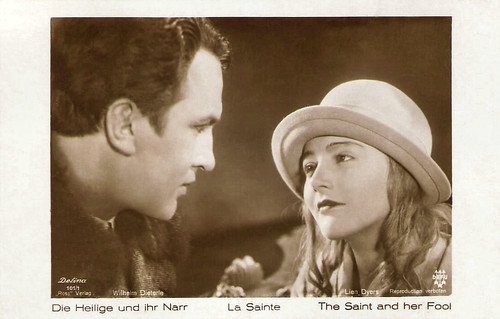
German postcard by Ross Verlag, no. 101/1, 1927-1928. Photo: Defina / DEFU. Publicity still for Die Heilige und ihr Narr/The Saint and her Fool (Wilhelm Dieterle, 1928) with Lien Deyers.

German postcard by Ross Verlag, no. 114/2. Photo: Deutsche Universal-Film. Publicity still for Das Schweigen im Walde/The silence in the forest (Wilhelm Dieterle, 1929) with Petta Frederick.
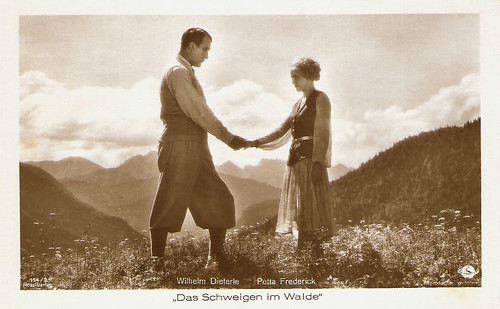
German postcard by Ross Verlag, Berlin, no. 114/3. Photo: Deutsche Universal-Film. Publicity still for Das Schweigen im Walde/The silence in the forest (Wilhelm Dieterle, 1929) with Petta Frederick.
When his contract with Warner expired, Wilhelm Dieterle broke with them and tried his own film company at RKO. When that failed, he mainly made films with MGM, Selznick and Paramount. During the 1940s, Dieterle focused on romantic, lush melodramas such as the Technicolor extravaganza Kismet (1944) with Ronald Colman and Marlene Dietrich, and Love Letters (1945) and Portrait of Jennie (1948), both with Joseph Cotten and Jennifer Jones. Love Letters became an enormous success and earned Jones an Oscar.
In the 1950s, Dieterle’s career declined during the McCarthyism period. In 1950 he went to Italy to shoot Vulcano, a rival to Roberto Rossellini’s Stromboli. When Anna Magnani heard that her former lover planned to make a film with his new girlfriend Ingrid Bergman on an Italian island near Sicily, Magnani pushed a Sicilian producer to make a rivalling film which had to come out before Rossellini’s. The affair was known as ‘la guerra dei vulcani’, also referring to Magnani’s tempestuous character.
Around the same time, Dieterle also shot in Italy the highly romantic September Affair (1950), with Joseph Cotten and Joan Fontaine. After he had returned to Hollywood, Dieterle made crime films like Dark City (1950) with Charlton Heston, Boots Malone (1952) and The Turning Point (1952), both with William Holden. He also filmed epic melodramas such as Salome (1953), starring Rita Hayworth and partly shot in Jerusalem, and Omar Khayyam (1956), starring Cornel Wilde and shot in the Bronson Canyon.
In 1958 Dieterle returned to Germany and worked till his death as a stage director for various companies in Germany, Switzerland and Austria; he also worked for German (Sender Freies Berlin) and Austrian television and (co-)directed two features: a remake of Joe May’s classic Herrin der Welt/Mistress of the World (1959-1960) starring Martha Hyer, and the thriller Die Fastnachtsbeichte/The Carnival Confession (1960) with Hans Söhnker.
From 1961 to 1965, he was manager of the theatre at Bad Hersfeld. He failed with an attempt to make a comeback in Hollywood with The Confession (1964) starring Ginger Rogers. The comedy a.k.a. Quick, Let's Get Married was a notorious flop. It would be Dieterle’s last film direction. From then on, he remained in Germany, working on the stage and on television. His last TV film was a new version of A Midsummer Night's Dream, Ein Sommernachtstraum (1968). Wilhelm Dieterle died in 1972 in Ottobrunn in Bavaria and was buried in Munich. From 1921 on, Wilhelm Dieterle was married to Charlotte Hagenbruch; after she died in 1968, his second wife was Elisabeth Daum.
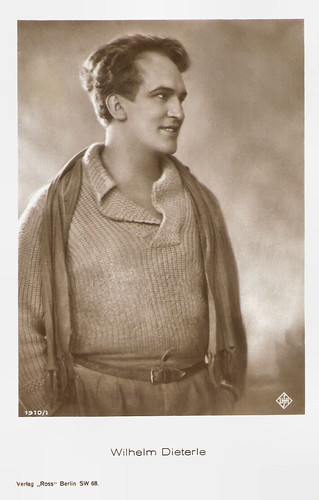
German postcard by Ross Verlag, Berlin, no. 1910/1, 1927-1928. Photo: Ufa.
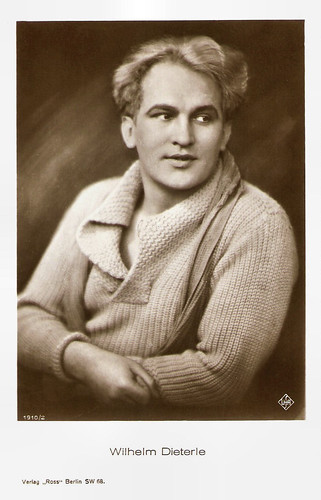
German postcard by Ross Verlag, Berlin, no. 1910/2, 1927-1928. Photo: Ufa.
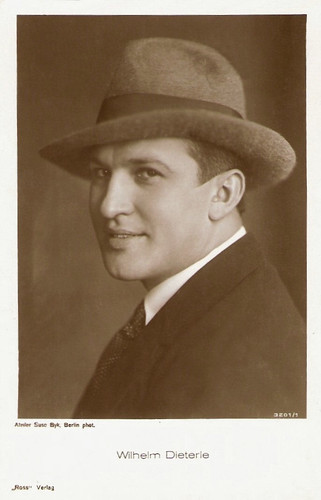
German postcard by Ross Verlag, no. 3201/1, 1928-1929. Photo: Atelier Suse Byk, Berlin.

German postcard by Ross Verlag, no. 4192/1, 1929-1930. Photo: Hanni Schwarz, Berlin.
First scenes of Das Wachsfigurenkabinett/Waxworks (Paul Leni, 1923-1924) with Dieterle as the poet. Source: Silentfilmdemocracy (YouTube).
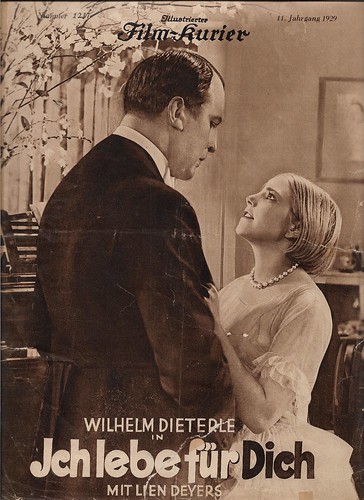
Cover of a special issue of Illustrierter Film-Kurier, 1929, no. 1217, for the late silent German film Ich lebe für dich (Wilhelm Dieterle, Universal 1929), starring William/Wilhelm Dieterle and Lien Deyers, and set in a Swiss tuberculosis sanatorium. For years, the young man Bergson has been awaiting his healing in a sanatorium and has become an embittered man. A new patient, the young, pretty, and lively Nicoline, brings sunshine into his life. Love and hope for bettering arise with him until Nicoline is declared to be healed again...
Sources: Wikipedia, Filmportal.de, Cinegraph (now defunct), and IMDb.
This post was last updated on 9 January 2024.

German postcard by Verlag Hermann Leiser, no. 3075. Photo: Atelier Oertel, Berlin-Wilm.

Austrian postcard by Iris Verlag, no. 971. Photo: Philipp & Co. Perhaps a card for the film Das Geheimnis des Abbe X (1927), directed by Dieterle himself, or for Der Pfarrer von Kirchfeld (1926), directed by Jakob and Luise Fleck.

German postcard by Ross Verlag, Berlin. Photo: Zelnik-Film. Wilhelm Dieterle in Die Weber/The Weavers (Friedrich Zelnik, 1927).

German postcard by Ross Verlag, no. 1741/1, 1927-1928. Photo: Atelier Balazs, Berlin / Zelnik Film.

German postcard by Verlag Hermann Leiser, Berlin-Wilm., no. 3926. Photo: Atelier Oertel, Berlin.
Kammerspiel
Wilhelm Dieterle was born in Ludwigshafen am Rhein in 1893. He was the youngest child of nine, to poor Jewish parents, Jacob and Berthe Dieterle. He took acting lessons at a young age and began his career as a stage actor in 1911 at the theatre in Arnsberg. This also included work as an extra, singer, dancer and stagehand; hence his white gloves, which he continued to wear in Hollywood.
His striking good looks and ambition soon paved the way as a leading romantic actor in theatre productions. In 1912-1914, he worked at theatres in Heilbronn, Plauen and Bad Dürkheim, and in 1914-1917 in Mainz under the direction of future film director Ludwig Berger. In 1917-1918 he played in Zürich, in 1918-1919 in Berlin and in 1919-1920 in Munich. He had his breakthrough in 1920-1923 with Max Reinhardt’s Deutschen Theater in Berlin. In this era, he mainly worked there, next to sidesteps with the companies of Leopold Jessner, Viktor Barnowsky and Karlheinz Martin. In 1924 Dieterle had his own theatre company, but it was short-lived.
His first film performance was in the Friedrich Schiller adaptation Fiesko (Carl Hoffmann, Phil Jutzi, 1913). He took up film acting from 1919 on in films like Die Vermummten/The Disguised Ones (Franz Seitz, 1920). All through the 1920s, he appeared in numerous films.
Dieterle appeared in major classics of the Weimar era. He was Henny Porten’s ill-fated fiancé and Fritz Kortner’s rival in love in the Kammerspiel Hintertreppe/Backstairs (Leopold Jessner, 1921). Actually, he was often paired with Porten, before Hintertreppe also in Die Geier-Wally/Wally of the Vultures Ewald André Dupont, 1921), and afterwards in Frauenopfer/Women's Sacrifice (Karl Grune, 1921).
Dieterle also was the poet, the Persian baker and the Russian prince in the Harun al Raschid and Iwan the Terrible sequences in Das Wachsfigurenkabinett/Waxworks (Paul Leni, 1923-1924). He played Henny Porten’s young husband in the internationally popular Mutter und Kind/Mother and Child (Carl Froehlich, 1924). He also played Gretchen’s brother Valentin in Friedrich Wilhelm Murnau’s Faust (1926), who was killed by Mephisto.

German postcard by Ross Verlag, no. 646/4. Photo: Henny Porten-Film. Henny Porten and Wilhelm Dieterle in Die Geierwally aka Die Geier-Wally (E.A. Dupont, 1921), based on the novel by Wilhelmine von Hillern. The sets were by Paul Leni.

German postcard by Ross Verlag, Berlin, no. 674/4. Photo: Krabbe / RO-Film. Conrad Veidt as Don Carlos and Wilhelm Dieterle as Marquis Posa in Carlos und Elisabeth/Carlos and Elisabeth (Richard Oswald, 1924).

German postcard by Ross Verlag, no. 682/3. Photo: FFG (Froehlich-Flm GmbH). Henny Porten in Mutter und Kind/Mother and Child (Carl Froehlich, 1924), co-starring Wilhelm Dieterle.

German postcard by Ross Verlag, no. 1469/1, 1927-1928. Photo: Aafa Film. Wilhelm (William) Dieterle in Zopf und Schwert - Die tolle Prinzessin (Victor Janson, 1926).

German postcard by Ross Verlag, no. 66/4. Photo: Ufa. Publicity still for Faust (1926) with Camilla Horn.
Sex in chains
From 1923 on, Wilhelm Dieterle directed his first films, in which he always played the lead. He started with the Heimat film Der Mensch am Wege/Man by the Roadside (1923), in which Marlene Dietrich played one of her first roles. The major example of his own output was Geschlecht in Fesseln/Sex in Chains (1928), one of the films produced by his own company Charha (1927), which he ran with his wife, scriptwriter and actress Charlotte Hagenbruch. Dieterle played a man who accidentally killed another man who tried to harass his wife (Mary Johnson). In jail, he is seduced by an inmate, while his wife gives in to another man as well. After his liberation, the couple feel guilty and commit suicide.
In particular, between 1928 and 1930, Dieterle directed many films for his own company, in which he starred and for which his wife signed the script, such as the melodrama Die Heilige und ihr Narr/The Saint and Her Fool (1928) with Lien Deyers and Gina Manès, and the mountain film Das Schweigen im Walde/The Silence in the Wood (1929). His German films were so successful internationally, that he was offered a contract by Warner Brothers in 1930 to make German versions of American sound films for Deutsche First National Pictures GmbH (Defina), the German department of Warner’s subsidiary First National. His first, The Last Flight (1931) with Richard Barthelmess, was a success and has been hailed as a forgotten masterpiece. Another example was Die heilige Flamme/The Holy Flames (1930-1931), co-directed with Berthold Viertel and starring Salka Viertel.
In the States, Dieterle stopped acting and focused on directing under the name William Dieterle. As he was Jewish, he was lucky to get away from the slowly worsening situation in Germany. Three years later, Adolph Hitler would take over and ban all Jews from the German film industry. In the US, Dieterle quickly adapted and was permitted to start directing his own films. With Michael Curtiz, Dieterle soon became the regular Warner film director, working in every possible genre, such as comedies with Kay Francis and the melodrama The Crash (1932) with Ruth Chatterton. Together with Max Reinhardt, with whom Dieterle had worked in Germany, he adapted A Midsummer Night’s Dream (1935) for the cinema, but the result failed to convince the critics.
In the early 1930s, Dieterle was highly productive for Warner, turning out 6 films per year in 1933 and 1934. He probably had to: in 1933 he had received a seven-year contract from Warner. From the mid-1930s on, Dieterle became well-known for his bio-pics. The Story of Louis Pasteur (1936) won him an Oscar nomination while The Life of Emile Zola (1937) got him the Oscar. In both films, Paul Muni played the lead. Other memorable titles were the Mark Twain adaptation The Prince and the Pauper (1937) with Errol Flynn, Juarez (1939) with Bette Davis, and The Hunchback of the Notre Dame (1939) with Charles Laughton as Quasimodo.
In 1937 Warner offered Dieterle, by now an American citizen, the opportunity to study Russian production methods during four months at Lenfilm in Moscow. In 1938-1940 he taught theatre lessons at the Max Reinhardt Workshop of Stage, Screen and Radio, and in 1939 he co-founded the antifascist cultural magazine The Hollywood Tribune and the English-spoken exile theatre company The Continental Players, directed by Leopold Jessner.

German postcard by Ross Verlag, no. 68/8. Photo: Atelier Balazs, Berlin / Henny Porten-Film. Henny Porten and Wilhelm Dieterle in the German silent drama Violantha (Carl Froehlich, 1927).

German postcard by Ross Verlag, Berlin, no. 77/3. Photo: Zelnik-Film. Publicity still for Die Weber (Friedrich Zelnik, 1927) with Hertha von Walther and Hermann Picha.

German postcard by Ross Verlag, Berlin, no. 77/4. Photo: Zelnik-Film. Publicity still for Die Weber (Friedrich Zelnik, 1927) with Paul Wegener.

German postcard by Ross Verlag, no. 101/1, 1927-1928. Photo: Defina / DEFU. Publicity still for Die Heilige und ihr Narr/The Saint and her Fool (Wilhelm Dieterle, 1928) with Lien Deyers.

German postcard by Ross Verlag, no. 114/2. Photo: Deutsche Universal-Film. Publicity still for Das Schweigen im Walde/The silence in the forest (Wilhelm Dieterle, 1929) with Petta Frederick.

German postcard by Ross Verlag, Berlin, no. 114/3. Photo: Deutsche Universal-Film. Publicity still for Das Schweigen im Walde/The silence in the forest (Wilhelm Dieterle, 1929) with Petta Frederick.
Romantic, lush melodramas
When his contract with Warner expired, Wilhelm Dieterle broke with them and tried his own film company at RKO. When that failed, he mainly made films with MGM, Selznick and Paramount. During the 1940s, Dieterle focused on romantic, lush melodramas such as the Technicolor extravaganza Kismet (1944) with Ronald Colman and Marlene Dietrich, and Love Letters (1945) and Portrait of Jennie (1948), both with Joseph Cotten and Jennifer Jones. Love Letters became an enormous success and earned Jones an Oscar.
In the 1950s, Dieterle’s career declined during the McCarthyism period. In 1950 he went to Italy to shoot Vulcano, a rival to Roberto Rossellini’s Stromboli. When Anna Magnani heard that her former lover planned to make a film with his new girlfriend Ingrid Bergman on an Italian island near Sicily, Magnani pushed a Sicilian producer to make a rivalling film which had to come out before Rossellini’s. The affair was known as ‘la guerra dei vulcani’, also referring to Magnani’s tempestuous character.
Around the same time, Dieterle also shot in Italy the highly romantic September Affair (1950), with Joseph Cotten and Joan Fontaine. After he had returned to Hollywood, Dieterle made crime films like Dark City (1950) with Charlton Heston, Boots Malone (1952) and The Turning Point (1952), both with William Holden. He also filmed epic melodramas such as Salome (1953), starring Rita Hayworth and partly shot in Jerusalem, and Omar Khayyam (1956), starring Cornel Wilde and shot in the Bronson Canyon.
In 1958 Dieterle returned to Germany and worked till his death as a stage director for various companies in Germany, Switzerland and Austria; he also worked for German (Sender Freies Berlin) and Austrian television and (co-)directed two features: a remake of Joe May’s classic Herrin der Welt/Mistress of the World (1959-1960) starring Martha Hyer, and the thriller Die Fastnachtsbeichte/The Carnival Confession (1960) with Hans Söhnker.
From 1961 to 1965, he was manager of the theatre at Bad Hersfeld. He failed with an attempt to make a comeback in Hollywood with The Confession (1964) starring Ginger Rogers. The comedy a.k.a. Quick, Let's Get Married was a notorious flop. It would be Dieterle’s last film direction. From then on, he remained in Germany, working on the stage and on television. His last TV film was a new version of A Midsummer Night's Dream, Ein Sommernachtstraum (1968). Wilhelm Dieterle died in 1972 in Ottobrunn in Bavaria and was buried in Munich. From 1921 on, Wilhelm Dieterle was married to Charlotte Hagenbruch; after she died in 1968, his second wife was Elisabeth Daum.

German postcard by Ross Verlag, Berlin, no. 1910/1, 1927-1928. Photo: Ufa.

German postcard by Ross Verlag, Berlin, no. 1910/2, 1927-1928. Photo: Ufa.

German postcard by Ross Verlag, no. 3201/1, 1928-1929. Photo: Atelier Suse Byk, Berlin.

German postcard by Ross Verlag, no. 4192/1, 1929-1930. Photo: Hanni Schwarz, Berlin.
First scenes of Das Wachsfigurenkabinett/Waxworks (Paul Leni, 1923-1924) with Dieterle as the poet. Source: Silentfilmdemocracy (YouTube).

Cover of a special issue of Illustrierter Film-Kurier, 1929, no. 1217, for the late silent German film Ich lebe für dich (Wilhelm Dieterle, Universal 1929), starring William/Wilhelm Dieterle and Lien Deyers, and set in a Swiss tuberculosis sanatorium. For years, the young man Bergson has been awaiting his healing in a sanatorium and has become an embittered man. A new patient, the young, pretty, and lively Nicoline, brings sunshine into his life. Love and hope for bettering arise with him until Nicoline is declared to be healed again...
Sources: Wikipedia, Filmportal.de, Cinegraph (now defunct), and IMDb.
This post was last updated on 9 January 2024.
1 comment:
What an amazing career, and a wide range of films. Thanks Bob
Post a Comment